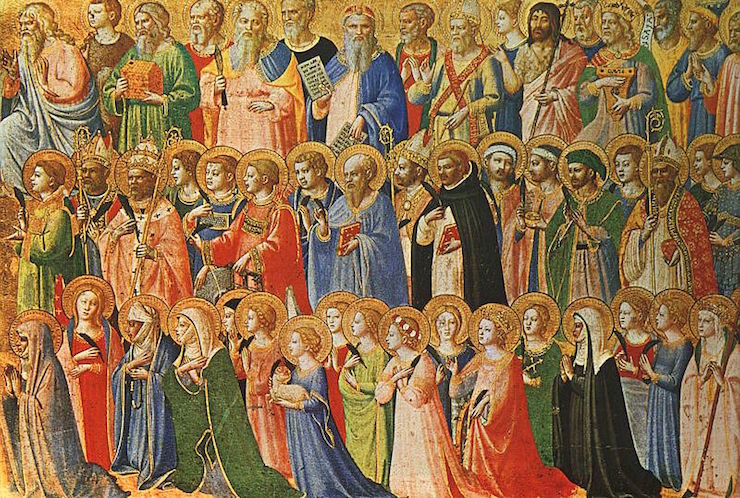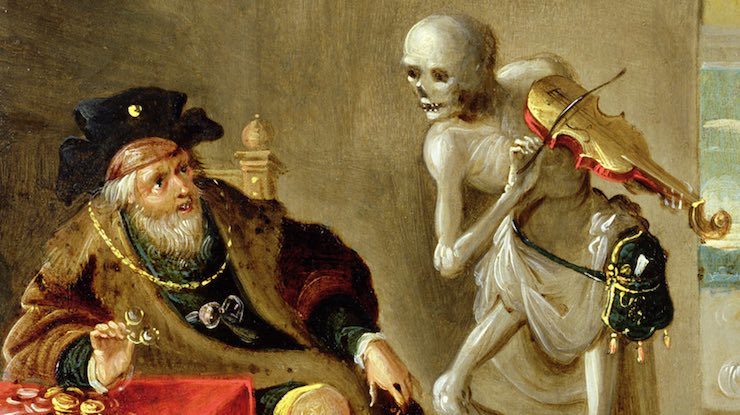We’ve been knee-deep in pumpkin spice for weeks, now, which means (1) Starbucks may be part of a secret cabal intent on world domination through tasty means, and (2) Halloween is nigh. We all know what Halloween is these days—costumes and candy, pumpkins and fright nights—but that doesn’t mean the holiday makes sense. Sure, it’s fun to play dress-up and eat buckets of candy, but how did such a strange tradition start? Why do we do it on the same day every year? In short, where did this whole Halloween thing come from?
Well, like most awesome things (the medievalist said with all the bias), it begins in the Middle Ages.
How? Let’s start with the word and see: Halloween.
It’s a funny-looking word when you think about it, and it’s been spelled that way since at least 1785, when it appears as such in the poem “Halloween,” by celebrated Scottish poet Robert Burns. Not long before that, though, the word was regularly spelled as Hallowe’en. Part of the reason Halloween looks a bit odd, therefore, is that it is a contraction (like don’t from do not or ’twas from it was). So what letter is missing from Hallowe’en?
We can find the missing bit in any number of places, but let’s go ahead and ride with the Bard. In his 1603 play Measure for Measure, Shakespeare references Halloween by calling it All-Hallond Eve (2.1.30). Our word Halloween, it seems, is multiply contracted: it’s really All-Hallows Evening. Like Christmas Eve, it’s an evening festivity prior to a holiday, which in this case is All Hallows’ Day, November 1.
Good, right? Except now you’re probably wondering what All Hallows’ Day is, and what any of this has to do with costumes. Well, this is where things get gloriously medieval…

Our word hallow comes from the Old English word halga, which means here a holy man—or, to be more precise, a saint. All Hallows’ Day is All Saints’ Day, a day to have a celebratory feast to honor the saints. And, yes, it is on November 1. As the prolific Aelfric of Eynsham says of November in his remarkable Old English grammar around the year 1000: “se monað ongynð on ealra halgena mæssedæg” [the month begins on the day of the mass for All Saints].
There is a reason All Saints’ Day is when it is. Like many other Christian holidays, the day is an attempt to redirect “pagan” beliefs. In this case, All Saints Day sits atop the old Celtic “New Year”—November 1, remember—which in Old Irish is called Samhain (pronounced “sow-in”), which literally translates as “summer’s end.” Samhain sets off three days of celebrations and feasts—because the Irish know how to party, amirite?—that mark the end of the (hopefully successful) harvest and another year passed.
And this is where things get really interesting. Because Samhain is also a festival to honor the dead.
For Celtic celebrants, summer was the “light” part of the year—think life—while winter was the “dark” part of the year—think death. And Samhain sits right there at the point that light turns to darkness, and life turns to death. (In case you’re curious, the holiday at the opposite end of the Celtic calendar was Beltane.) It is no surprise, then, that within this culture Samhain became associated with the “thinning” of the borders between the worlds of the living and the dead. On Samhain, the spirits of the other world were thought to roam more freely, which was a positively frightening prospect.
Luckily, if you disguise yourself as one of these spirits—perhaps even acting out the supernatural—you might be able to prevent them from harming you.
For obvious reasons, much of this imagery was related to death: skeletons and ghosts, pale faces and big eyes. All the same stuff you see in “Day of the Dead” celebrations, which occurs at the same time in Mexican and some Latin American cultures.
Anyway, in 1048 the Christian Church placed All Souls’ Day, the day to pray for the dead, on November 2 (right in the middle of those three days of Samhain). After Purgatory became a thing, prayers for release of the dead from purgation became a regularity, and a tradition soon developed in which children would sing such prayers at the doors to homes in exchange for small cakes (“souls”). Christmas Carols, in other words, but with yummy treats at the end.
The Church succeeded in taking over the name of the holiday and putting a Christian overlay upon it, but cultural practices are much harder to squash. The older Samhain traditions of otherworldly tricksters and disguises persisted and ultimately remain the reason I’ll be dressing up as a barbarian again this year. Rawr.
As it happens, purgatorial prayers are also part of the reason we have jack o’lanterns at Halloween. It was an existing tradition at harvest celebrations to carve vegetables (usually turnips, as it happens) and place lit candles in them. At the same time, the Church would commemorate (or pray for) souls in Purgatory by lighting candles. Wrap it up with Celtic otherworld imagery, and you have that grinning jack o’lantern.
So there you have it. The pumpkin spiced origins of Halloween, a holiday most medieval.
This article was originally published in October 2016 as part of our Medieval Matters series.
 Michael Livingston is a Professor of Medieval Culture at The Citadel who has written extensively both on medieval history and on modern medievalism. His historical fantasy trilogy set in Ancient Rome, The Shards of Heaven, The Gates of Hell, and the newly released The Realms of God, is available from Tor Books.
Michael Livingston is a Professor of Medieval Culture at The Citadel who has written extensively both on medieval history and on modern medievalism. His historical fantasy trilogy set in Ancient Rome, The Shards of Heaven, The Gates of Hell, and the newly released The Realms of God, is available from Tor Books.











The purpose of the harvest festivals is to prepare for winter. There were three harvest festivals of which Samhain is the third. The first is Lughnasadh (1 August), the feast of apples when the fruits were gathered. Mabon (21 September) is the second, the feast of bread, when the cereal crops were harvested, threshed and stored for winter. The third and last harvest festival was Samhain, the harvest of meat. Farmers assessed how much fodder they had and how many animals they could feed over winter. The rest were slaughtered at Samhain and the meat that could not be preserved was eaten during the three days of feasting. Because the veil between the worlds was thin at this time of year, all were welcomed at the feasts, poor and rich alike, even complete strangers who just happened to wander in. It was dangerous to turn anyone away from the Samhain feast, for it might be a departed relative come back to their old haunts. You offended the spirits of the dead at your peril.
I miss Medieval Matters, and wish Michael Livingston would resume the column. Surely he can’t be out of materia!!
For a different take on whether there’s any pagan roots or even connections for Halloween read https://historyforatheists.com/2021/10/is-halloween-pagan/
Very interesting, thanks

What, no mention of the Soul Cake Duck?